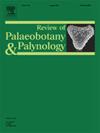Palynology of the Early Pleistocene Kalibiuk and Kaliglagah Formations at Bentasari, Central Java, Indonesia
IF 1.7
3区 地球科学
Q2 PALEONTOLOGY
引用次数: 0
Abstract
The Kaliglagah Formation in Central Java, of early Pleistocene age, yields abundant vertebrate fossils that predate the oldest occurrences of Javanese Homo erectus. This formation, together with the underlying Kalibiuk Formation, outcrops in the neighbourhood of Bentasari village, 20 km to the west of the classic outcrops at Bumiayu, Central Java. A 100 m exposure of this section was studied for palynology and sequence biostratigraphy. The analysis suggests that the section studied comprised two transgressive-regressive deltaic packages which probably formed as a result of two 41 kyr obliquity-driven climate cycles. It indicates that the Kalibiuk Formation comprises lower delta plain and delta front sediments that formed part of a large delta which was dominated by mangroves of the family Rhizophoraceae as well as Sonneratia (Sonneratiaceae). The lowermost part of the Kaliglagah Formation also formed on the lower delta plain of this delta, but the vegetation consisted mainly of the mangrove fern Acrostichum (Pteridaceae), together with the mangrove palm Nypa and the climbing fern Stenochlaena palustris (Blechnaceae). The upper part of the studied section of the Kaliglagah Formation formed on the upper delta plain in an open freshwater swamp setting vegetated mainly with Jussiaea (Onagraceae), Pandanus (Pandanaceae), Hanguana (Hanguanaceae) and Polygonum (Polygonaceae). The terra firma vegetation during time of deposition of the succession consisted of grassy savanna in the lowlands, indicating a strongly seasonal climate, and montane forests with Podocarpaceae in the upper catchment. The swamp and terra firma vegetation succession are compared to that in Perning, East Java, and other Javanese hominid sites.
The Kalibiuk and lower part of the Kaliglagah Formation, and also the Pucangan Formation at the Perning Homo erectus site, yielded the age-restricted palynomorph Stenochlaenidites papuanus, the parent plant of which went extinct across Sunda during the early Pleistocene, emphasising the older age of these localities compared to other Javanese hominid sites, such as Sangiran and Trinil where this taxon is missing.
印度尼西亚中爪哇Bentasari早更新世Kalibiuk和Kaliglagah组孢粉学
爪哇中部的卡利拉格地层,在更新世早期,发现了大量的脊椎动物化石,比爪哇最古老的直立人出现的时间还要早。这个地层,连同下面的Kalibiuk地层,在中爪哇Bumiayu经典露头岩层以西20公里处的Bentasari村附近露头。对该剖面进行了100 m暴露的孢粉学和层序生物地层学研究。分析认为,该剖面由两个海侵-海退三角洲包组成,可能是由两个41 kyr倾角驱动的气候旋回形成的。表明Kalibiuk组由下三角洲平原和三角洲前缘沉积物组成,形成了以根藻科红树林和海桑(Sonneratiaceae)为主的大型三角洲。Kaliglagah组的最下半段也形成于该三角洲的下三角洲平原上,但植被主要为红树林蕨类植物Acrostichum(蕨类科)、红树林棕榈Nypa和攀爬蕨类植物Stenochlaena palustris (Blechnaceae)。卡利拉格组上部形成于三角洲上部平原,为开阔的淡水沼泽环境,主要植被有菊科植物(onagracae)、香豆科植物(Pandanus)、汉瓜科植物(Hanguana)和蓼科植物(Polygonum)。演替沉积时期的陆地植被主要为低海拔地区的草地稀树草原,具有强烈的季节气候特征,而上游流域的山地森林则具有足足科植物。并与Perning、东爪哇和其他爪哇古人类遗址的沼泽和陆地植被演替进行了比较。在Kalibiuk和kaliiglagah组的下半部分,以及Perning直立人遗址的Pucangan组,发现了年龄有限的palynomorph Stenochlaenidites papuanus,其母系植物在更新世早期在巽他岛灭绝,与其他爪哇原始人遗址(如桑吉兰和特里尼尔)相比,强调了这些地方的年龄更老。
本文章由计算机程序翻译,如有差异,请以英文原文为准。
求助全文
约1分钟内获得全文
求助全文
来源期刊
CiteScore
3.50
自引率
21.10%
发文量
149
审稿时长
6 months
期刊介绍:
The Review of Palaeobotany and Palynology is an international journal for articles in all fields of palaeobotany and palynology dealing with all groups, ranging from marine palynomorphs to higher land plants. Original contributions and comprehensive review papers should appeal to an international audience. Typical topics include but are not restricted to systematics, evolution, palaeobiology, palaeoecology, biostratigraphy, biochronology, palaeoclimatology, paleogeography, taphonomy, palaeoenvironmental reconstructions, vegetation history, and practical applications of palaeobotany and palynology, e.g. in coal and petroleum geology and archaeology. The journal especially encourages the publication of articles in which palaeobotany and palynology are applied for solving fundamental geological and biological problems as well as innovative and interdisciplinary approaches.

 求助内容:
求助内容: 应助结果提醒方式:
应助结果提醒方式:


